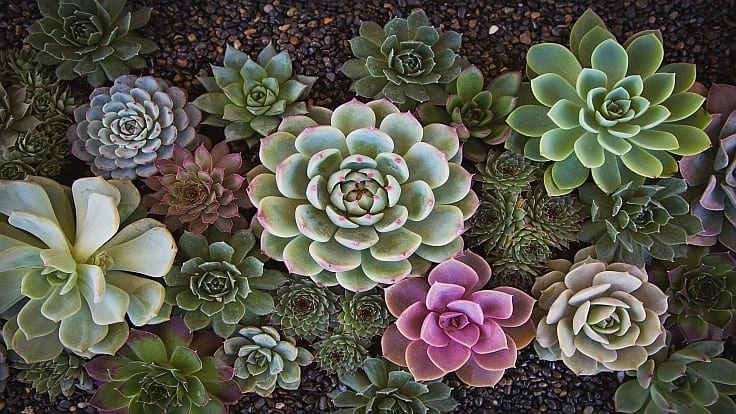
Photo Credit Adobe Stock
Succulents — those tiny, cacti-looking weird spikey plants that are becoming more and more ubiquitous at IGCs and even in Big Box retailers — were a big seller during the 1970s and 1980s, and like most consumer trends, they’ve come full circle and are once again a hot seller.
“By 2027, succulents will be an $8 billion in revenue annual business segment,” he shares, adding that Moss started growing succulents with 200 flats back in 2021 and today they’re averaging 5,000 flats of succulents annually.
Some key revelations about succulent production that Holley shared during his presentation at the AmericanHort Finished Plant Conference in mid-October:
- Having a wide variety available to your customers is key, he says. “You won’t be successful if you’re offering just one or two varieties, you’ve got to have more to round out that program.”
- Currently, Dümmen Orange is the main supplier of URCs of succulents to commercial growing operations. And they include a color tag with each flat of URCs, which is valuable for growers that don’t have time to mess around with creating custom tags. Moss has also sourced from Quality Cuttings in the past.
- On the subject of which soil mixes are best, Holley says that succulents like a sandy-loam soil. But since most growers don’t have ready access to enough sand to mix into their custom-blended mixes, he recommends SunGro’s #4 mix with some added perlite to help with drainage and mimic naturally sandy soil. Berger’s #5 mix is another option they’ve found workable with succulents.
- Sunlight is your friend as a succulent grower, he says. The plants thrive in hot, sunny and humid conditions in the greenhouse, and the best vegetative growth will occur when they are grown on raised benches. “And, if you’ve got hanging basket production above them, or just multiple levels of plants, make sure they are not having water dripped down on them from the other plants. That’s no bueno,” he says.
- Water sparingly, because succulents do not require a lot of water. “A good rule of thumb is to let them dry down completely before watering, even up until they start to show some wilting,” Holley advised. And watering in the morning is best so that the medium has plenty of time to drain and dry down before nighttime. Implement a weekly flush with clear, pH’d water as well to keep salt buildup down.
- Some people will tell you that you can only grow succulents in the spring, which Holley says a recent research study from Cornell University has disproven. “You can grow them any time of year where you have enough light,” he says. “I was initially surprised at the sales we saw during winter, and they really tie in nicely with our tropicals program.”
- Keep the growing medium pH between 5.7-6.3, and electrical conductivity (EC) readings in the .75-.80 range. Usually, a fungicide application within 24 hours of first sticking is effective at maintaining plant health. Fertilize the succulents regularly, especially since doing so helps draw out more vivid colors, Holley adds.
- One of the best parts of growing succulents in the greenhouse is that, in general, they are a low pest pressure crop, he says. But keep an eye out for mealy bugs between the leaf and the stem, and scale bugs are another pest that will attack succulents if given the opportunity. A broad-spectrum insecticide is usually effective in controlling both of those pests.
Latest from Greenhouse Management
- Anthura acquires Bromelia assets from Corn. Bak in Netherlands
- Top 10 stories for National Poinsettia Day
- Langendoen Mechanical hosts open house to showcase new greenhouse build
- Conor Foy joins EHR's national sales team
- Pantone announces its 2026 Color of the Year
- Syngenta granted federal registration for Trefinti nematicide/fungicide in ornamental market
- A legacy of influence
- HILA 2025 video highlights: John Gaydos of Proven Winners





